
The Soča River in northwestern Slovenia has always served as a crossroads of history. It saw several border changes in the 20th century. A wealth of archeological findings, some housed in a local museum, indicate that the area was significant even before the Roman Era.
In the middle of the 19th century, locals near the town of Most na Soči – then known as Sveta Lucija --, stumbled upon several iron pots. Several decades later, archeologists found extensive evidence of ancient homes. Based on the artifacts, researchers determined that a thriving community existed in the area in the 8th century B.C. Their discovery of more than 7000 Iron Age gravesites indicates that the settlement was quite extensive.
The location of the settlement was not a coincidence. The area lay on Europe’s Emerald Trade Route that connected the Mediterranean with the continent’s north. Throughout the year, thousands of objects were bought and sold along the route. Others were made in one of several workshops that lined the Soča River.
The area remained prosperous well into the Roman Era. The houses were typically large and many even had indoor plumbing – a luxury that would not return to the Soča River Valley until the modern era. Precious jewelry is among the most common artefacts from that period.
On the initiative of a man named Drago Svoljšak, a small museum has been established to present the area’s ancient heritage to both locals and visitors. Housed in a local elementary school, it uses various artifacts to reconstruct a street inhabited by traders, potters and blacksmiths – a street that once existed on the spot now occupied by the school.
Through the centuries, the political significance of Most na Soči gradually declined. But every once in a while, events such as the retreat of Napoleon’s army through the Soča River Valley or the frontlines of the World War I-era Isonzo Front, served as a reminder of the town’s strategic significance – the reason why so many civilizations left a mark on this remote part of Slovenia.

































































